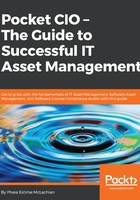
上QQ阅读APP看书,第一时间看更新
Why manage IT assets?
A vast many organizations choose to either not manage their IT assets or only manage part of their assets. Many who attempt ITAM are usually only taking physical inventory or just doing a cursory software license discovery process in preparation for an audit. Although these processes are better than nothing, and they certainly have their place, they do not offer the insight and clarity required to determine the return on your organization's IT spend. Only an organizational commitment to manage IT resources in a holistic enterprise approach can help you achieve that. Also, again, ITAM can, and should, be used as a corporate strategy.
If you are looking for good reasons to start managing IT assets more effectively, consider these:
- Cost: In IT and business, change is a constant, and along with every change comes a cost. Typically, the upfront purchase or investment in technology accounts for roughly 4% to 20% of those costs. The remainder is spread over the entire life cycle of your IT assets. These costs include equipment (including software installation), managing changes, maintenance, upgrades, virtualization, service or help desk setup and maintenance, and disposal. Arriving at an accurate figure for the cost of your IT assets is a challenge. Additionally, getting the most out of your IT infrastructure investment is virtually impossible when there is no accurate record of the organization's IT assets and how they are supporting critical business services.
- Dependency: IT enables your business to operate globally on a 24x7 basis. Given this, your IT infrastructure is too important to be left unmanaged. ITAM should play an important role, adding value to your organization's growth strategies. However, uncovering this role requires a clear understanding of the relationships and dependencies involved with these mission-critical assets.
- Hardware replacement (technology refresh): Whether you like it or not, the pressure to stay competitive is going to drive you to replace IT hardware assets every 3 years. Given that today's hardware has a 3-year "life" before it becomes obsolete, this is a reasonable expectation. Also, if a major shift in technology develops, you may find yourself replacing your entire array of hardware assets.